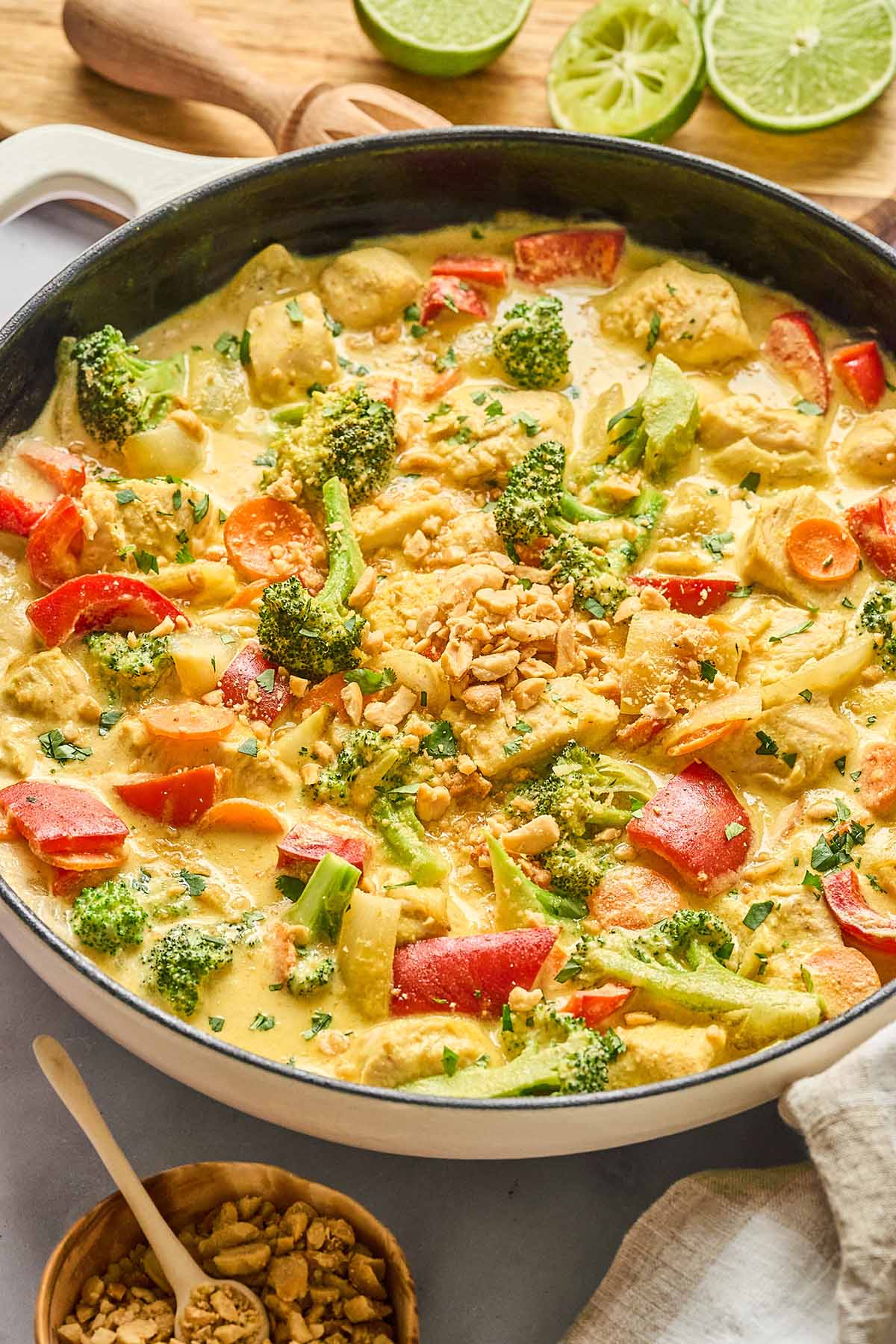
This yellow curry chicken with vegetables is the perfect blend of comfort and flavor. Chicken, vegetables, and coconut milk come together with Thai yellow curry paste to create a dish that’s satisfying yet surprisingly easy to make.
The mild heat of the curry is balanced by the sweetness of coconut milk, making it approachable for all spice levels.
It’s quick enough for busy weeknights but flavorful enough to serve at a casual gathering. Plus, it’s perfect for meal prep since the flavors deepen beautifully over time. Serve it over jasmine rice or with naan for a delicious, complete, and comforting meal.
Reasons to Love This Recipe
Ingredient Overview
Be sure to check out the full recipe and ingredient list below
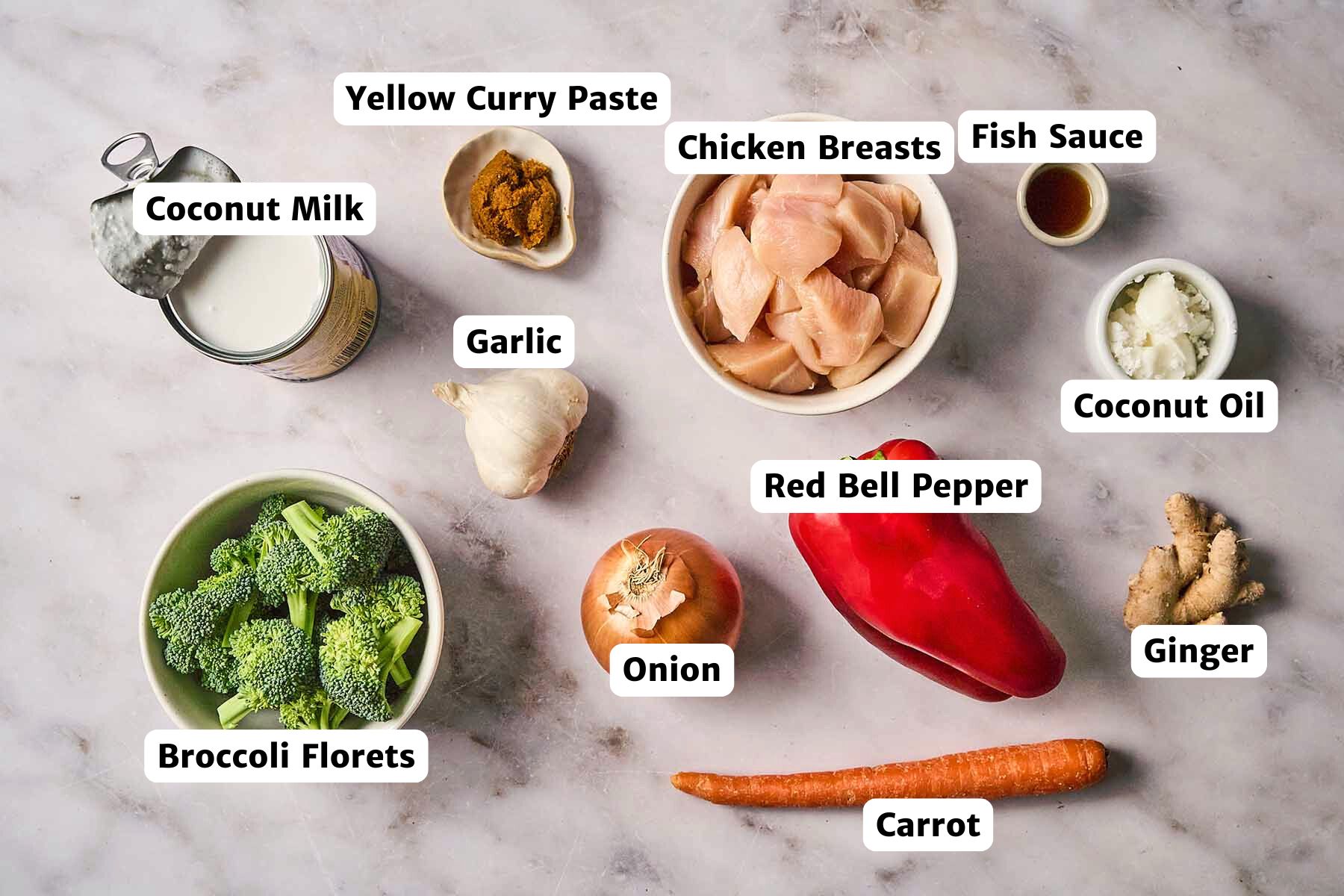
- Coconut Oil. Coconut oil adds a subtle sweetness and flavor that complements the curry paste. For something with more neutral flavor, you can substitute it with avocado oil, vegetable oil, or olive oil.
- Onion. Chopped onion forms the aromatic base of the curry. Yellow or white onions work best, but you can also use shallots.
- Garlic. Fresh minced garlic adds flavor. If you’re out of fresh garlic, substitute with ½ teaspoon garlic powder for each clove.
- Ginger. Freshly grated ginger adds warmth and a slightly spicy kick. If you don’t have fresh ginger, you can substitute with ¼ teaspoon ground ginger. The flavor will be milder.
- Thai Yellow Curry Paste. This is the star of the dish. Start with ½ tablespoon and adjust to taste. If you can’t find yellow curry paste, red or green curry paste will work, but they’ll change the flavor profile a bit.
- Chicken Breasts. Boneless, skinless chicken breasts cook quickly and stay tender in the curry. You can substitute with chicken thighs for a richer flavor or use tofu for a vegetarian option.
- Carrot. Sliced carrots add a touch of sweetness and a nice crunch. Substitute with sweet potato or butternut squash for a similar texture and sweetness.
- Red Bell Pepper. Red bell peppers add sweetness and color. Yellow or orange bell peppers can be used instead, or swap with snap peas or green beans.
- Broccoli Florets. Broccoli adds texture and absorbs the curry sauce well. Cauliflower or green beans make good substitutes if you prefer a different vegetable.
- Coconut Milk. Full-fat coconut milk creates a creamy, rich sauce. Light coconut milk can be used to reduce fat, but the sauce will be thinner. If you need a non-coconut option, cashew cream or heavy cream (if dairy is allowed) are good alternatives.
- Fish Sauce. Fish sauce adds umami and saltiness. If you want to keep the dish vegetarian, substitute with soy sauce, tamari, or coconut aminos.
- Water. Water helps adjust the consistency of the curry. For a richer flavor, you can substitute with chicken broth or vegetable broth.
- Optional Garnishes. Fresh cilantro, lime wedges, chopped peanuts, and scallions enhance the flavor and presentation. If you’re not a fan of cilantro, try fresh basil or parsley instead. For a nut-free option, skip the peanuts or use toasted pumpkin seeds.
Step-By-Step Instructions with Photos
This is a brief overview. Be sure to check out the full recipe and ingredient list below
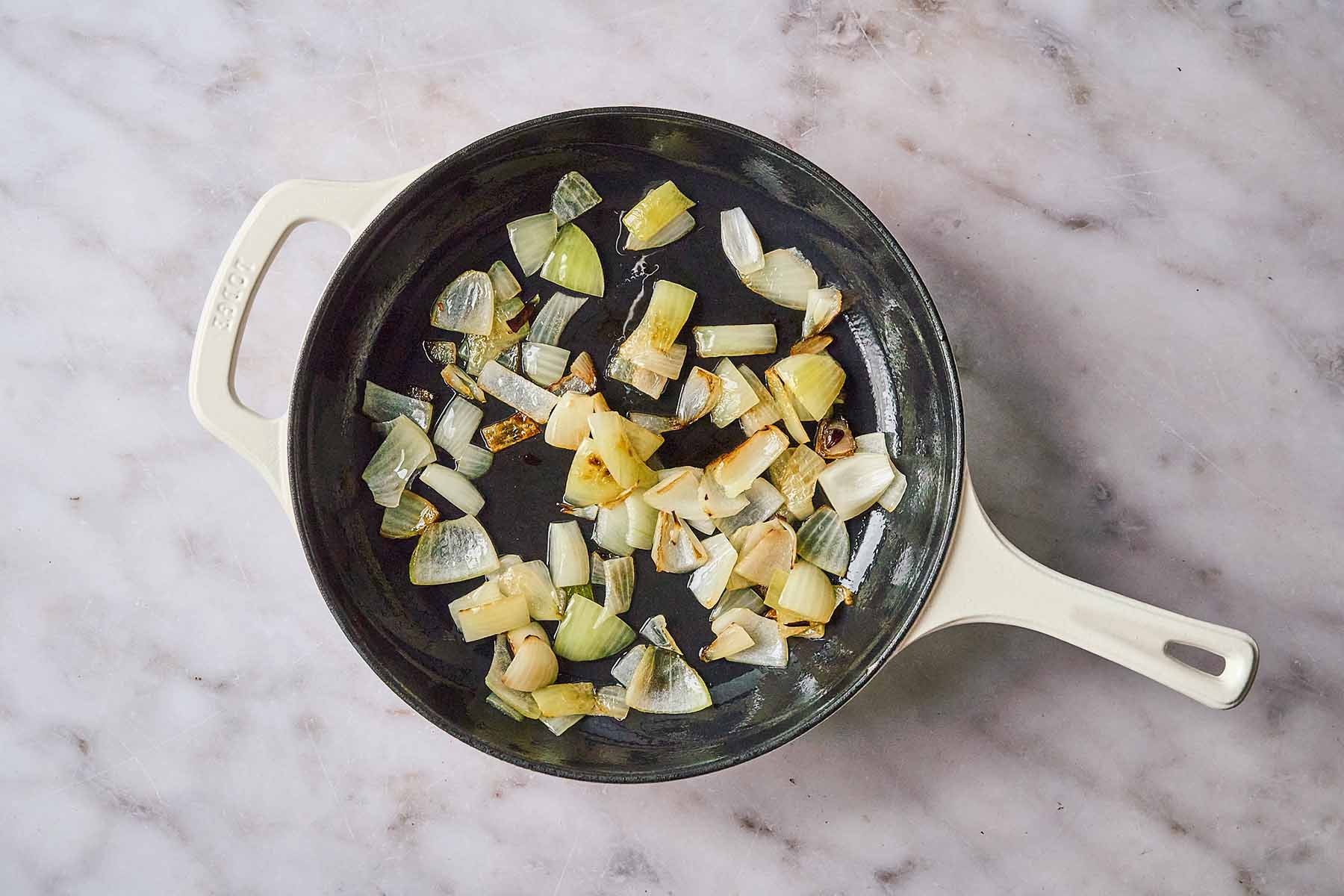
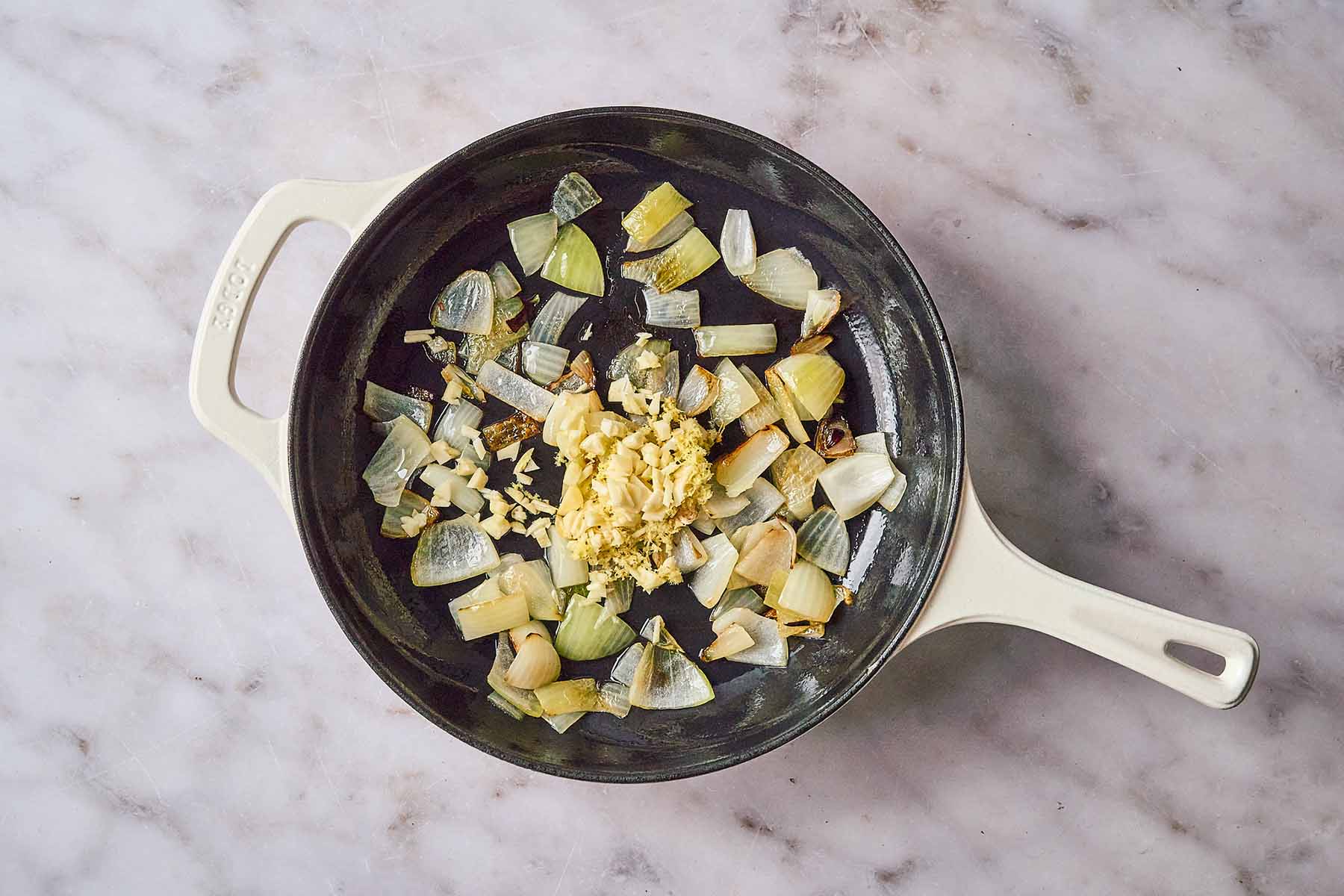
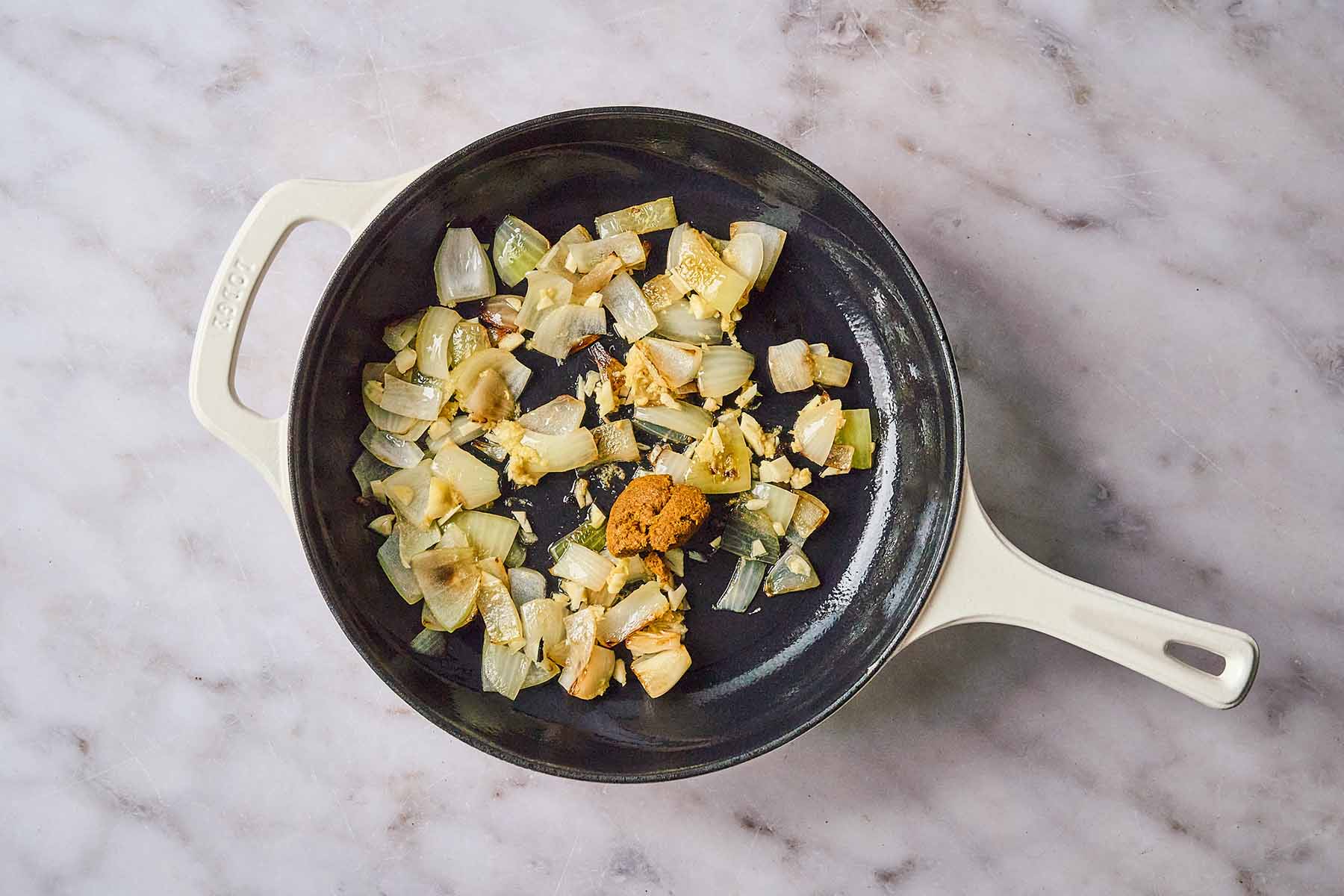
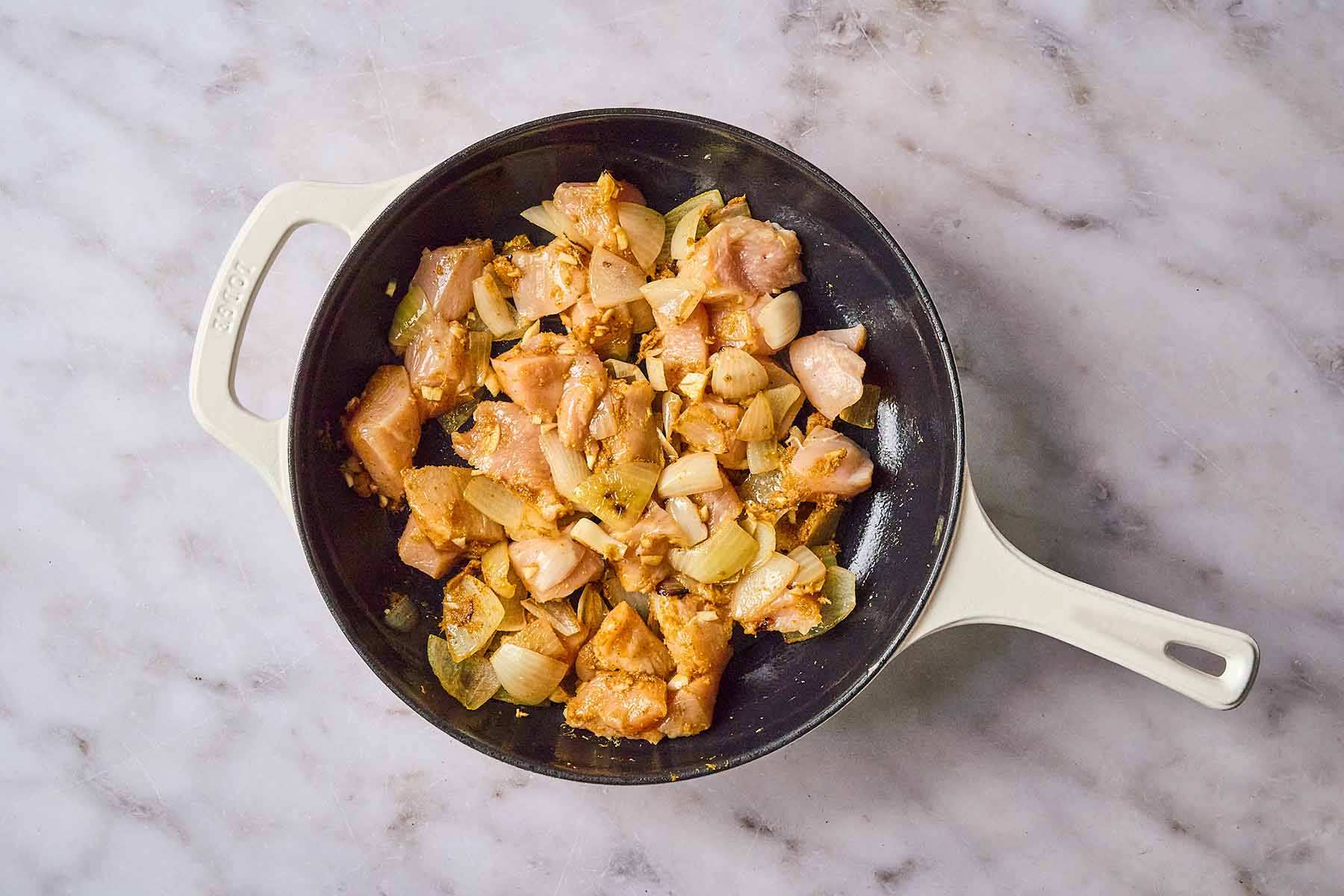
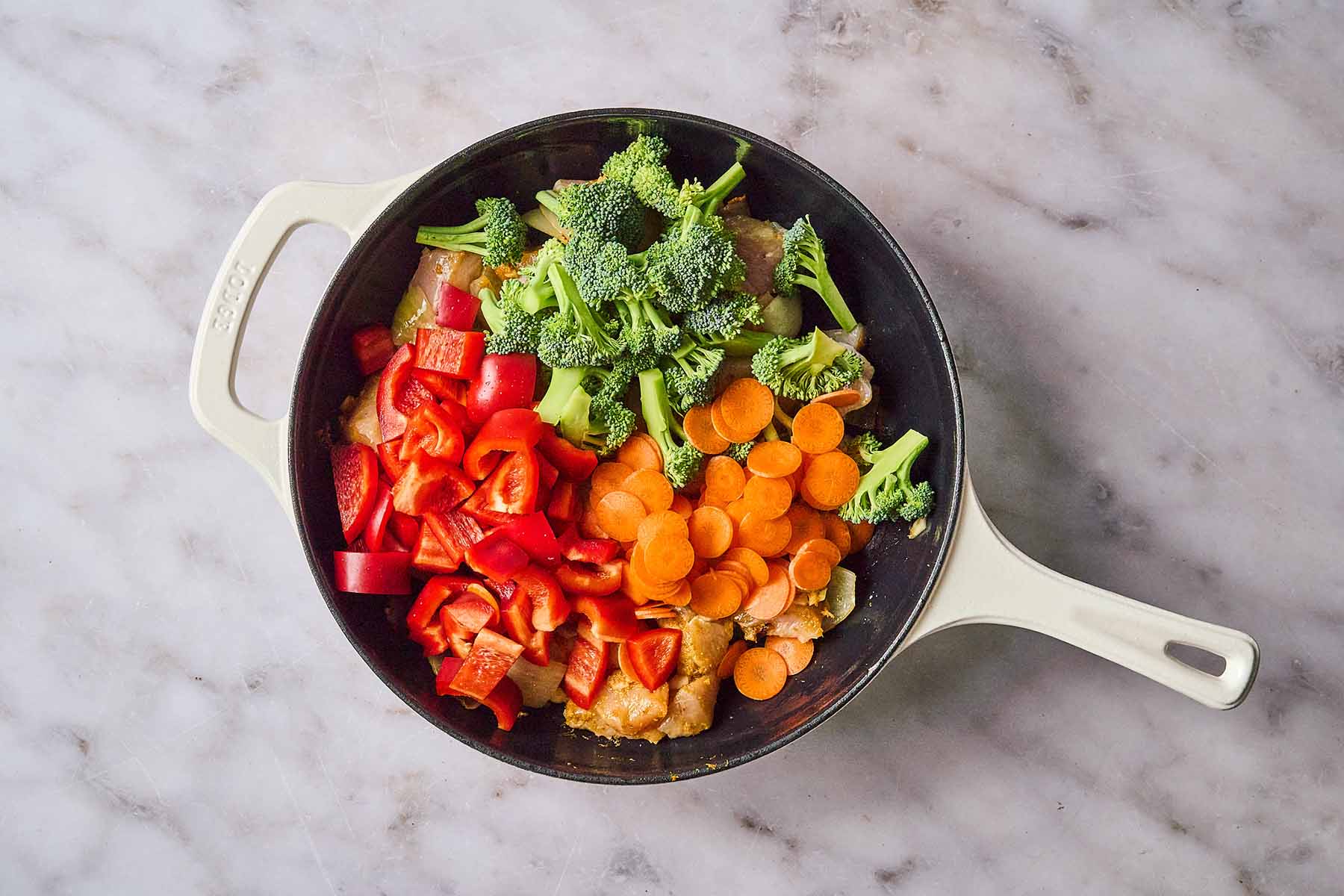

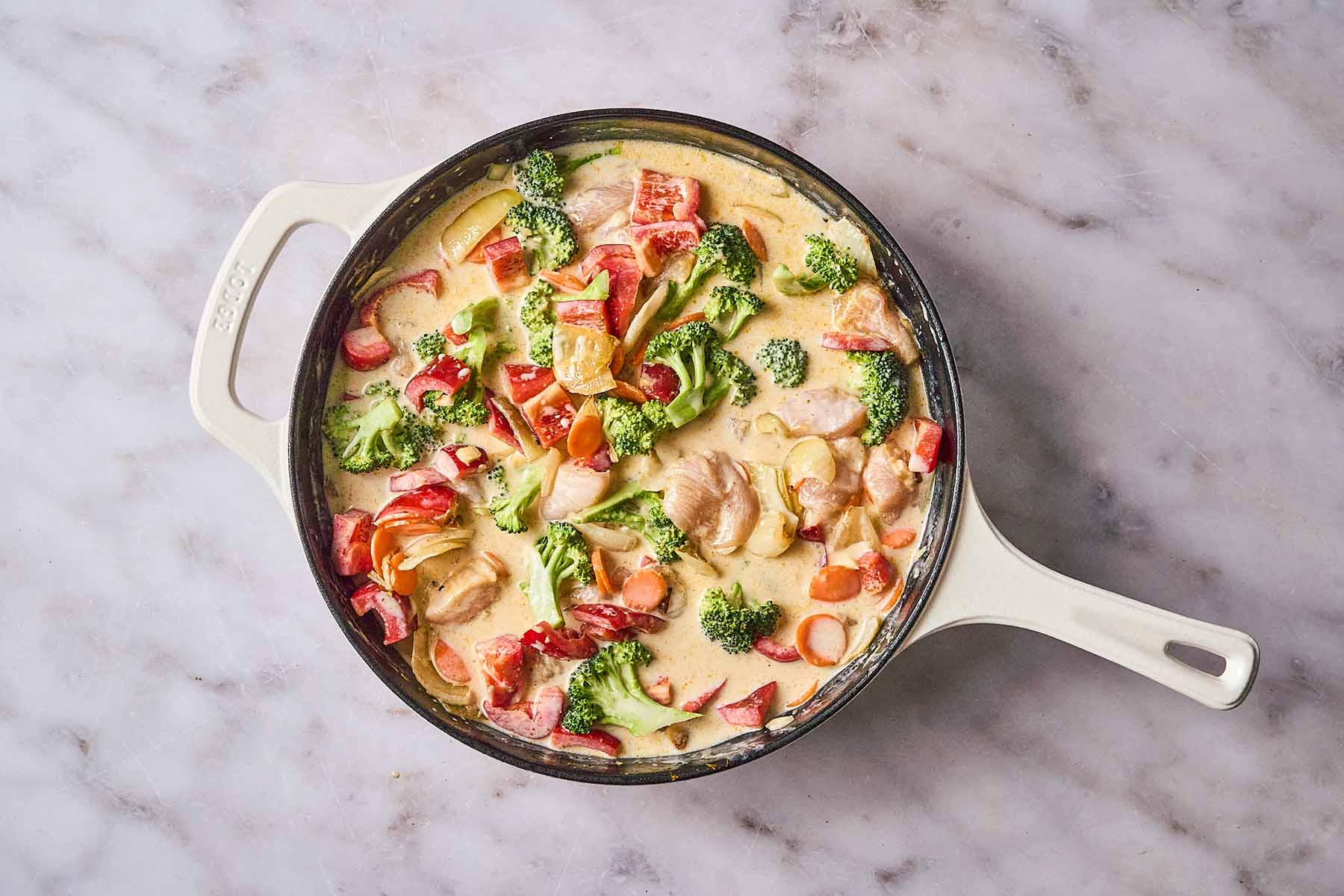
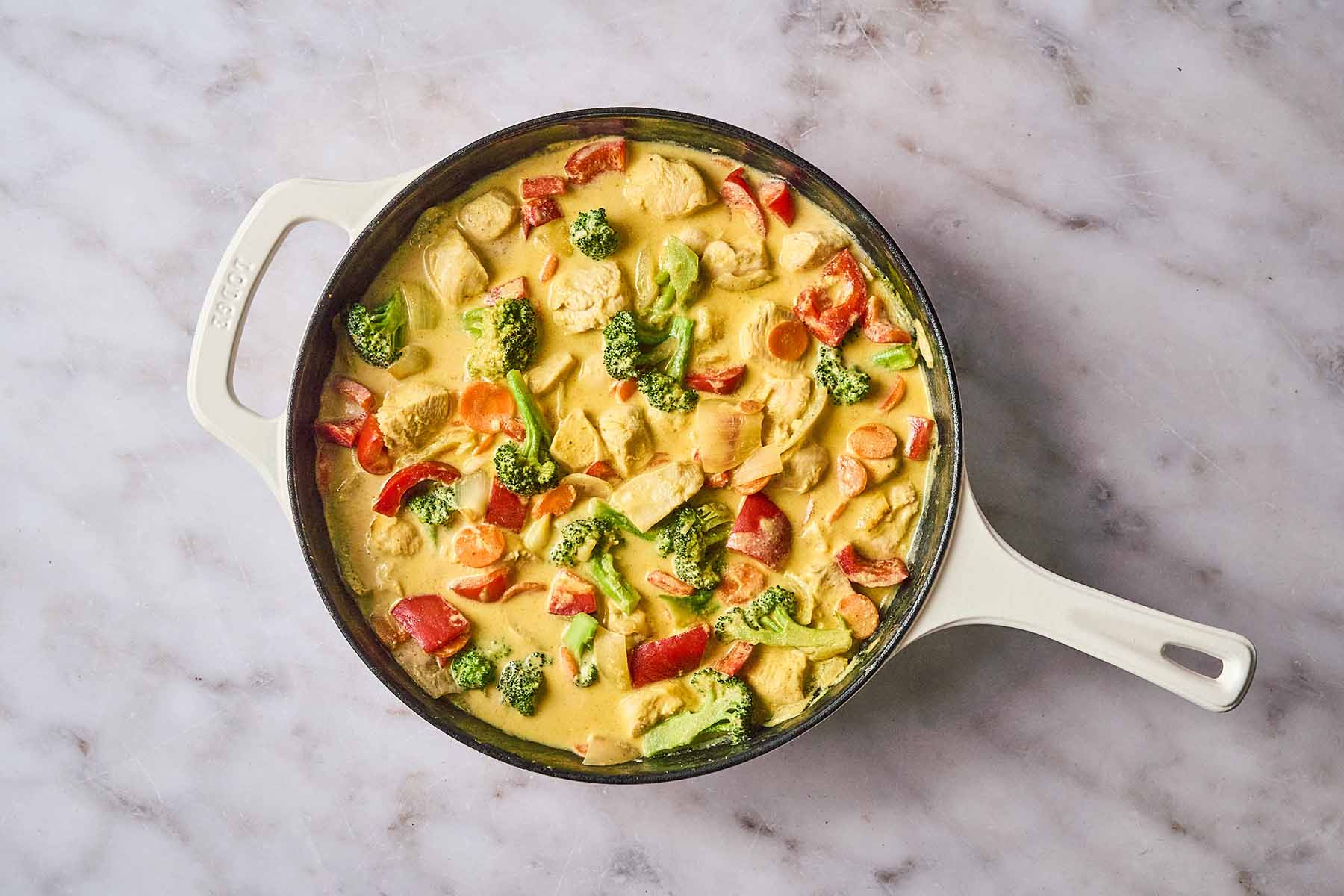
Tips for Success
- Toast the Curry Paste. Cooking the curry paste for 1–2 minutes before adding the chicken helps unlock its full depth of flavor. Don’t skip this step!
- Chop Ingredients Evenly. Chop the chicken and vegetables into similar-sized pieces for even cooking.
- Use Full-Fat Coconut Milk. Full-fat coconut milk gives the curry a rich, creamy texture. Light coconut milk will work, but the sauce will be thinner.
- Don’t Overcook the Vegetables. For crisp-tender vegetables, add them after the chicken has partially cooked and simmer just until tender. Overcooking will make them mushy.
- Adjust the Heat Level. Start with ½ tablespoon of curry paste and increase to taste. If it’s too spicy, balance it out with a little more coconut milk or a pinch of sugar.
- Taste and Adjust Seasoning. After simmering, taste the curry and adjust the flavors by adding more fish sauce or a squeeze of lime juice.
- Thicken the Sauce (Optional). If the sauce is too thin, stir together 1 teaspoon cornstarch with 1 tablespoon cold water and add to the curry. Simmer for 1–2 minutes until thickened.
- Garnish Just Before Serving. Add chopped cilantro, lime wedges, and peanuts right before serving for fresh flavor and crunch.
- Make It Vegetarian. Substitute tofu or chickpeas for the chicken and use soy sauce or coconut aminos instead of fish sauce for a vegetarian version.
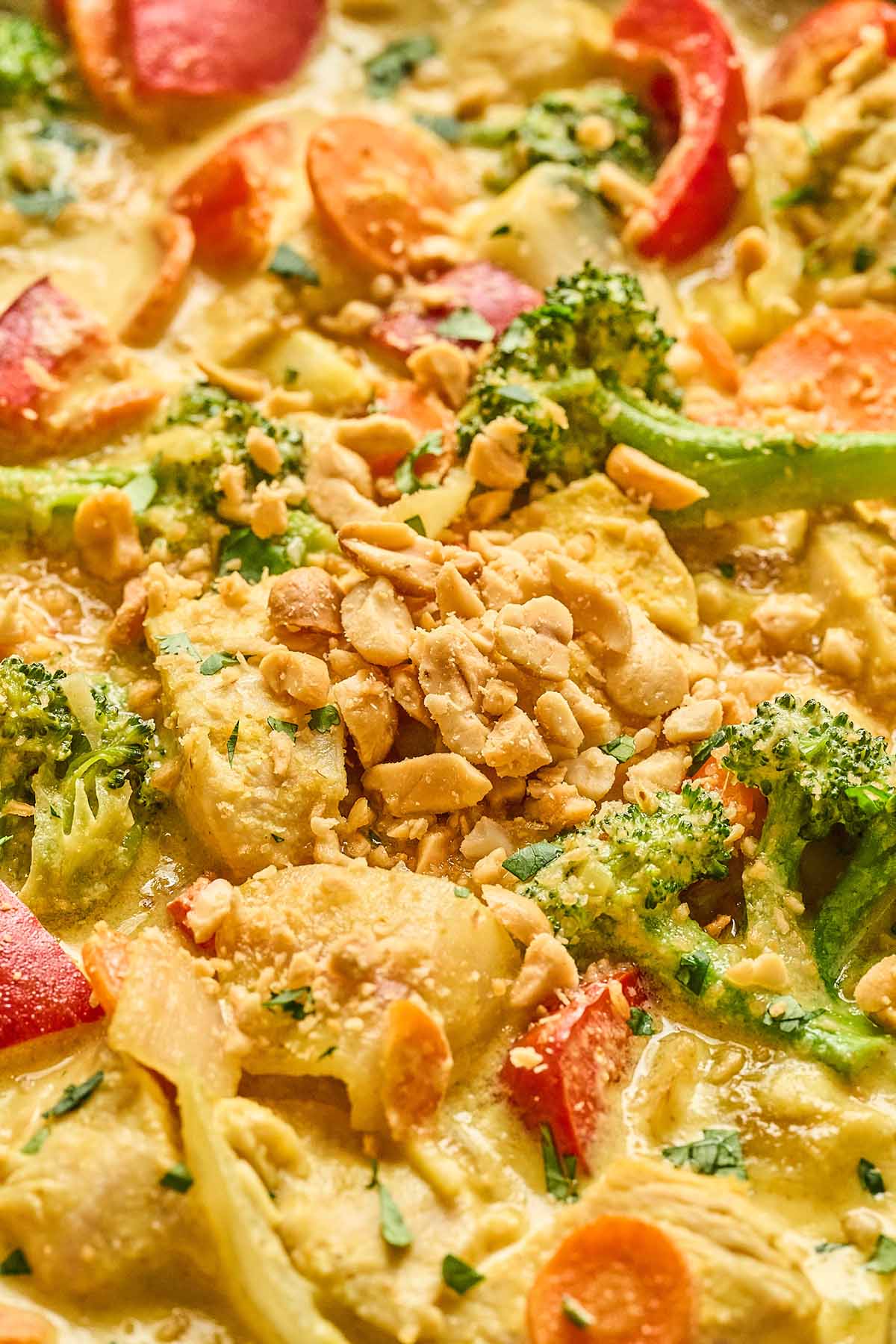
Would you like to save this recipe?
Storage and Reheating
Refrigerator. Let the curry cool completely, then store it in an airtight container in the refrigerator for up to 4 days.
Freezer. Once cooled, transfer the curry to a freezer-safe container and freeze for up to 2 months. Thaw overnight in the refrigerator before reheating.
Reheating:
- Stovetop. Warm the curry over medium heat, stirring occasionally, until heated through. If the sauce is too thick, add a splash of coconut milk or water to adjust the consistency.
- Microwave. Heat in a microwave-safe bowl in 30-second intervals, stirring in between, until warmed through.
👉 Tip: For best results, add fresh garnishes like cilantro, lime wedges, and peanuts after reheating to restore flavor and texture.
more
Comforting Recipes
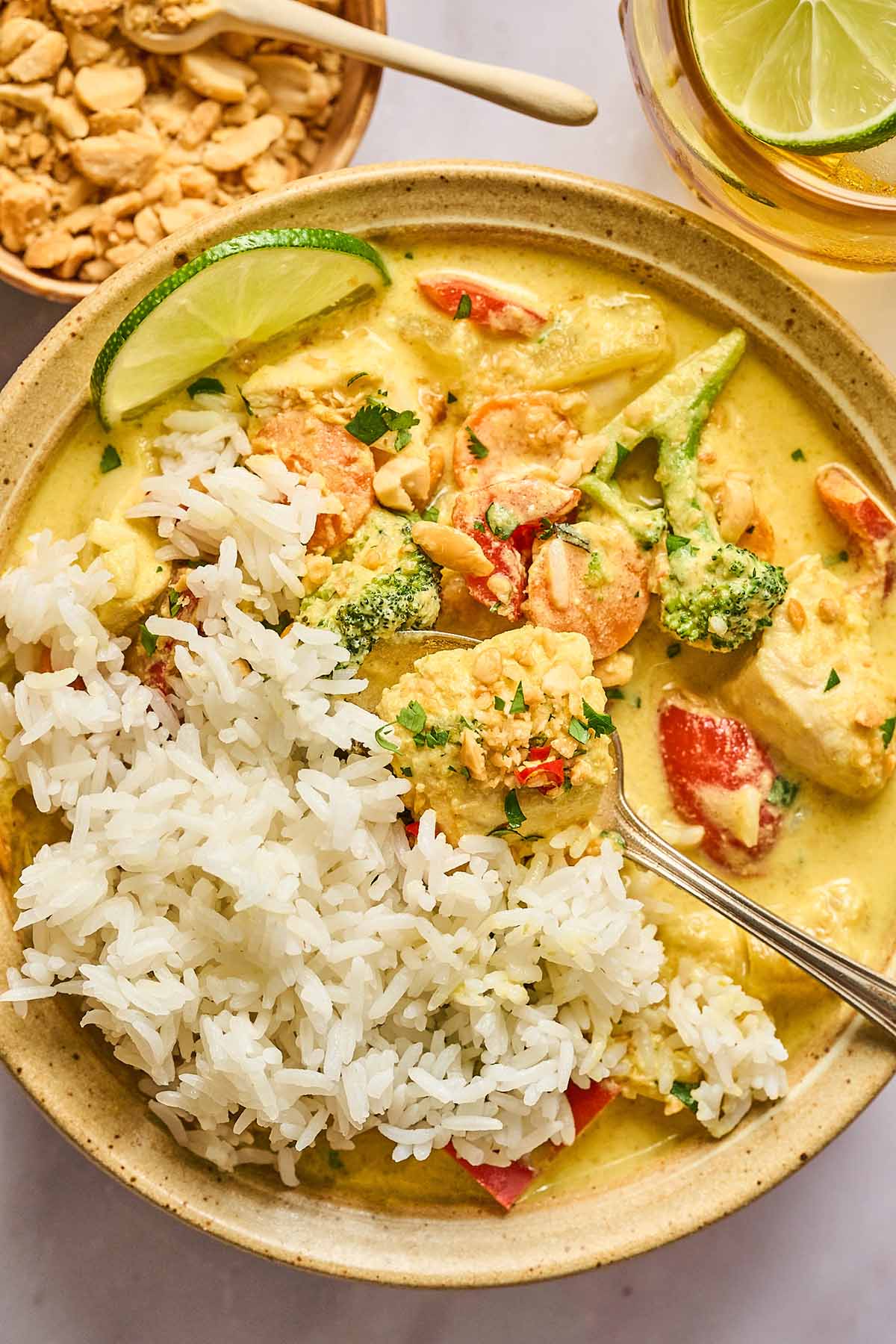
Yellow Curry Chicken with Vegetables Recipe
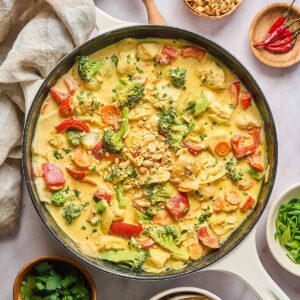
Equipment
Ingredients
- 2 tablespoons coconut oil unrefined virgin (Note 2)
- 1 cup chopped onion
- 3 cloves garlic minced
- 1 tablespoon ginger freshly grated
- ½ to 1 tablespoon Thai yellow curry paste adjust based on spice preference (Note 3)
- 1 pound chicken breasts boneless, skinless, cut into 1-inch pieces (Note 4)
- 1 medium carrot sliced into thin coins
- 1 cup red bell pepper chopped
- 1 ½ cups broccoli florets
- 1 14 oz can coconut milk full fat (Note 5)
- 2 teaspoons fish sauce (Note 6)
- ½ cup water
- Optional Garnishes: Fresh cilantro leaves lime wedges, chopped peanuts, scallions
Instructions
- Heat the 2 tablespoons coconut oil in a large skillet or wok over medium heat. Add the 1 cup chopped onion and cook for 3–4 minutes, stirring occasionally, until softened and lightly browned. Stir in the minced 3 cloves garlic and 1 tablespoon ginger, cooking for about 1 minute until fragrant.
- Add ½ to 1 tablespoon Thai yellow curry paste and cook for 1–2 minutes, stirring constantly to toast the spices and deepen the flavor. (Note 3).
- Add the 1 pound chicken breasts pieces. Stir until evenly coated in the paste.
- Add the sliced 1 medium carrot, chopped 1 cup red bell pepper, and 1 ½ cups broccoli florets, stir again until evenly coated in the paste.
- Pour in the 1 14 oz can coconut milk, 2 teaspoons fish sauce, and ½ cup water. Bring the mixture to a gentle boil, then reduce to a simmer. (Note 7) (Note 8)Cook uncovered for 15–20 minutes, stirring occasionally, until the chicken is fully cooked and the vegetables are tender-crisp.
- The chicken should reach an internal temperature of 165 F (74 C) with a meat thermometer (Note 9).Adjust and thicken (if needed). Taste the curry and adjust seasoning with more fish sauce or a pinch of salt if needed. If the sauce is too thin, stir together 1 teaspoon cornstarch with 1 tablespoon cold water and add to the curry. Simmer for 1–2 minutes until thickened (Note 10).Serve and garnish. Serve hot, garnished with cilantro, lime wedges, chopped peanuts, and scallions if desired.
Notes
- A large, heavy-bottomed skillet or wok works best for even heat distribution and easy stirring.
- Use unrefined (virgin) coconut oil for a richer flavor that complements the curry.
- Some Thai yellow curry pastes are spicier or saltier than others. Start with ½ tablespoon and add more if desired.
- Cutting the chicken into even 1-inch pieces ensures even cooking and juicy results.
- Full-fat coconut milk gives the curry a creamy texture. Light coconut milk can be used, but the sauce will be thinner.
- If you prefer to keep this dish vegetarian or don’t have fish sauce on hand, you can substitute with soy sauce or coconut aminos for a similar salty, umami flavor.
- Avoid boiling the curry. A few bubbles here and there are all you need to gently poach the chicken and keep the vegetables tender-crisp. Boiling too vigorously can toughen the chicken and make the vegetables soggy.
- Don’t worry if the sauce seems thick when you first mix everything together. As the vegetables cook, they release liquid, naturally thinning the sauce to the perfect consistency.
- Chicken should reach an internal temperature of 165 F (74 C).
- If the sauce is too thin, use a cornstarch slurry (1 teaspoon cornstarch mixed with 1 tablespoon cold water) to thicken it.
Nutrition
MEAL PREP TIPS
- Double the Recipe. Make a double batch to have enough for both immediate serving and meal prep.
- Cool Completely. Let the curry cool to room temperature before storing.
- Portion Out. Divide the curry into individual airtight containers, pairing with jasmine rice, basmati rice, or cauliflower rice if desired.
- Store Properly.
- Refrigerator. Store in the fridge for up to 4 days.
- Freezer. Store in freezer-safe containers for up to 2 months. Thaw overnight in the fridge before reheating.
- Reheat Carefully. Reheat in the microwave or on the stovetop over medium heat until warmed through. If the sauce is too thick, add a splash of coconut milk or water to loosen it up.
- Add Fresh Garnishes. Top with cilantro, lime wedges, and chopped peanuts after reheating for the best flavor and texture.
For a quicker lunch, portion the curry over cooked rice and freeze it in individual servings for easy grab-and-go meals!